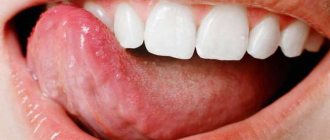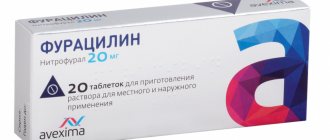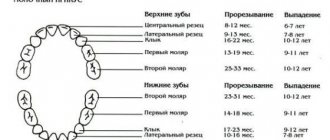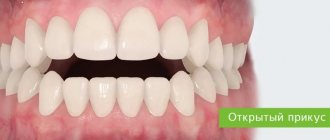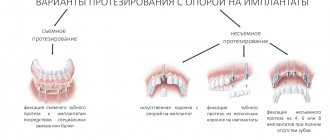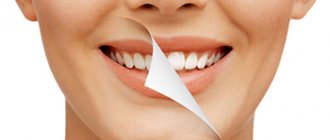Signs Causes Types Complication Diagnostics Treatment methods Prevention Doctors Work
Crossbite occurs in 2% of patients
. These are children and adults. There are many variations of it; quite often this type of occlusion is associated with other anomalies. Malocclusion can be treated, but it must be started as soon as deviations from the norm are noticed. Otherwise, therapy alone may not be enough.
Causes and consequences of crossbite
There are many reasons for crossbite. They are divided into two types - congenital and acquired. The first includes the following:
- genetic predisposition or heredity;
- viral or somatic diseases suffered by a woman during pregnancy;
- bad habits and unbalanced diet.
As for the external causes of crossbite, most of them are associated with a very early age. These include:
- birth head injuries;
- injuries received in the first year of life;
- long-term use of pacifiers and nipples;
- the child's habit of sucking his thumb or foreign objects such as toys, pens, etc.;
- habit of propping one's cheek with one's fist or palm.
If such factors have influenced the formation of the bite, parents should begin treatment of the pathology as early as possible.
There are also reasons that can affect bites at any age, even as an adult. They are associated with disruption of the endocrine system, the presence of bone and joint diseases, as well as a significant decrease in immunity.
The consequences of crossbite directly depend on the quality of its treatment. If you carry out therapy on time, you can get rid of the disease completely. However, if timely assistance is not provided, the patient may face the following complications:
- Due to the inability to chew food well, its large solid parts will provoke gastrointestinal diseases.
- Due to the displacement of the jaws, defects in the placement of the tongue, lips and other parts of the face may occur, which causes aesthetic discomfort and speech disorders.
Important! It should be remembered that malocclusions that are not corrected in childhood may be difficult to correct in adults. In some cases, the desired effect will not occur. Therefore, it is better to start treatment as early as possible.
Signs of cross occlusion
One of the visible symptoms is definitely facial asymmetry:
- the corners of the lips are located at different heights, which is why the smile is shifted (crooked);
- the jawline is deviated from the central axis.
Visual asymmetry in crossbite is not the only sign; it is also observed:
- incorrect placement of teeth in the mouth, crowding;
- changes in the functioning of the TMJ (temporomandibular joint). This causes discomfort, unpleasant sensations, pain when yawning, wide opening of the mouth;
- uneven load on teeth leads to rapid wear and easy access to caries;
- wedge-shaped defect;
- tension in the jaw muscles leading to frequent pain;
- injury to the cheek mucosa due to involuntary biting.
In addition to the above symptoms, crossbite displacement is sometimes accompanied by a speech defect when pronouncing whistling, hissing sounds.
Classification and stages of crossbite
Crossbite has several varieties:
- Lingual, in which the upper jaw expands and the lower jaw narrows. It can be observed on one side or both. It happens with or without displacement.
- Buccal – expansion of the lower jaw with a parallel narrowing of the upper. It may also have a displacement and be observed on one or both sides.
- Buccal-lingual is a combined type of bite that combines the characteristics of the previous two.
Also, the types of crossbites are divided based on the stage at which the pathology is at a particular moment. In this case, the following main stages are distinguished:
- milk stage, when malocclusion is observed in young children before the growth of permanent teeth begins;
- replaceable - occurs at the stage of replacement of the milk dentition with permanent ones;
- constant, which can be said to exist in the presence of a defect after the appearance of permanent teeth.
Depending on the type of defect and the stage of its development, the doctor can select the most effective treatment.
Complications
Different lengths of the articular condyles on the right and left on the OPTG.
It is advisable to identify and eliminate cross-occlusion in childhood. In this case, it is not worth waiting until the teeth have all erupted or something else (as many doctors advise) - this is fraught with consequences, since the incorrect (forced) position of the lower jaw creates conditions for blocking the growth of the condylar (articular) process of the lower jaw and, over time , facial asymmetry, caused by the difference in the length of the articular processes, can firmly fix (perpetuate) the incorrect position of the lower jaw already at the bone level. And then only the operation...
During a direct examination by a specialist, you will be able to find out your exact diagnosis, as well as receive a referral for diagnosis or a treatment plan.
Crossbite in a child
Crossbite in a child can appear both at a very early age and at a later date. Its rudiments can begin to form in the prenatal period or after birth under the influence of external factors. The difference from adults is that children's crossbite is more treatable, and as a result, a person can completely get rid of such a disease.
With displacement of the lower jaw
Regardless of the type of crossbite, if it is present, movement of the lower jaw may occur. It can be either pronounced or almost invisible. However, we must not forget that over the years such a defect may worsen. Therefore, its treatment should be started as early as possible.
Buccal
Buccal crossbite occurs quite often in children, compared to other types of this pathology. At the same time, the lower dentition expands significantly. The lower teeth themselves may also become wider, overlapping the upper teeth.
Unilateral
These crossbites are more common than bilateral crossbites. This pathology is characterized by the presence of expansion or narrowing on only one side of the jaw. Often, such defects are more amenable to correction, as they require less intervention. Their consequences are also not as dangerous as in the case of a bilateral defect.
Diagnostics
For diagnosis, specialists use a set of studies to determine the degree of crossbite displacement:
- visual examination: recording asymmetry of the lips, chin, signs in the oral cavity (crowding of teeth, overlap of the buccal tuberosities), injuries from improper closure of the buccal mucosa;
- use of a bite roller;
- x-ray, orthopantomogram, teleroentgenogram, CT, MRI (according to indications to choose from);
- axylography as an additional method.
Photos are taken before and after to see the progress of the correction process.
Crossbite in the anterior region is very often similar to mesial bite, but these are radically different pathologies. A cross bite in this form is much easier to treat than a mesial bite; they should not be confused, so a thorough diagnosis is needed.
Crossbite treatment
Crossbite treatment should begin immediately when such a disorder is detected. If its first signs were seen at an early age, then therapy will require less time and may be limited to the use of special bandages, mouth guards or plates. It is also very important at the initial stage of bite treatment to determine the root cause of the pathology. If it is associated with the work of any other internal systems, for example, endocrine, then it must first be fully treated.
Trainers
Trainers are the most common designs for the treatment of such an ailment as crossbite in children. They are special mouthguards made of silicone according to an individual impression. They should be worn night and day, removing for eating, socializing or playing. Such mouthguards apply pressure to the dentition, thereby moving the teeth into the desired position.
Aligners and aligners
Mouthguards and aligners have a similar effect to trainers, but differ in their shape. Such designs are intended for constant wear in case of malocclusion. They are placed separately on each row of teeth so that the jaw can open freely. Typically, these devices are made from transparent materials to make them as invisible as possible to others.
Bracket systems
Braces are considered one of the most effective designs used for the treatment of malocclusions. Such devices consist of separate braces that are attached to the teeth and a special arch. It is she who, with her traction force, moves the teeth to their anatomical location.
Osteotomy
In some cases, an osteotomy may be required to remove a crossbite. This is a surgical procedure during which the doctor cuts soft tissue and bone. After that, he installs them in the right place and fixes them.
What are the differences between bite forms?
It is possible to distinguish what type of malocclusion is manifested in a patient visually. If the central line of the dentition coincides, then everything is in order with the facial skeleton. Since the jaw slides to the wrong position only when it is closed, the problem is at the level of the teeth, and it is quite easy to fix it - a long course of treatment with aligners is enough for this.
If the line does not match, then this indicates improper formation of the jaw. Developed asymmetry, atypical proportions of the chin, all this is a consequence of the skeletal form of the disorder. Only surgical intervention or a combined effect will restore the correct shape of the jaw.
Prevention and prognosis
Prevention of such a defect as crossbite should begin during a woman’s pregnancy. She should lead a healthy lifestyle, watch her diet, and exercise moderately. It is also important to avoid all kinds of infections and viruses. To do this, it is better to avoid visiting crowded places and communicating with carriers.
After the baby is born, he needs constant monitoring. At this stage, it is important to choose the right pacifier and pacifier, and, if possible, do without these devices. To do this, it is better to consult a pediatric dentist or pediatrician. It is also necessary to ensure that the child does not get carried away with thumb sucking or toys, and does not receive any injuries to the facial part of the head.
The prognosis of such a malocclusion depends on how well the treatment was carried out. Often the defect can be completely removed.
Important! Do not forget that at the initial stage only a specialist can identify dental deformation. Therefore, it is necessary to visit the dentist regularly from the moment the first baby teeth grow.
Causes
The reasons why crossbite occurs are as follows:
- narrowing of the jaw;
- atypical position of tooth buds;
- early/late teething or change of milk teeth, loss of chewing units before term. Adjacent elements simply fill the free space;
- long-term bad habits (lip biting, thumb sucking, etc.);
- injuries, complications after surgical procedures;
- bone diseases can cause deep bite;
- mouth breathing. When you breathe through your mouth, the tongue goes down and does not put pressure on the upper jaw as it should, and the lips and cheeks continue to act in the opposite direction and, accordingly, the upper jaw arch narrows and deepens, a crossbite occurs;
- heredity, genetic predisposition;
- a birth defect, a pathology that occurs during pregnancy, or a birth injury.
You can often hear the statement that the pathology of the bite is influenced by the position of a person during sleep.
Treatment prices
The cost of treating crossbite depends on the degree of damage, the individual characteristics of the patient, as well as the professionalism of the doctor and the level of the clinic in which the therapy will take place. Typically, prices for a full range of services start from 8 thousand rubles. In some cases, if it is necessary to wear special structures or perform an operation, the total cost can rise to 30-60 thousand rubles.
The iOrtho clinic network provides high-quality services for correcting malocclusion with Invisalign aligners, sign up for a consultation now!
What it is
A crossbite is a bite in which the lower jaw is displaced to the side in relation to the upper jaw.
It is also called a “scissor bite” or scissor bite. With a lateral displacement of the jaw, it turns out that on one side the lower teeth overlap the upper ones, and on the other, the upper teeth overlap the lower ones. Such a shifted (or oblique) bite needs correction. This is what orthodontists do. In severe cases, the assistance of a specialist in dental surgery may be required.
Why does it occur
Crossbite can be acquired or congenital. In the first case we are talking about the consequence:
- improper healing of bones after jaw fractures;
- bad habit of constantly resting one cheek with your hand;
- infantile type of swallowing;
- scoliosis;
- rickets.
The congenital form of the disease is the result of its inheritance or abnormalities in the development of the fetus during pregnancy.
It has also been noted that cross-disorder can occur due to the premature loss of a large number of teeth or their improper eruption.
Manifestations
Symptoms of cross-disocclusion include intraoral, facial and functional signs.
Facial symptoms of pathology include:
- asymmetrical face;
- moving the chin to any side;
- lateral displacement of the lower lip;
- retraction of the upper lip on the same side;
- flattening of the face in the lower part.
When examining the oral cavity, characteristic signs are also revealed.
These include:
- violation of contact between the chewing surfaces of molars;
- narrowing or expansion of one of the dentitions;
- crossing of the dentition when the jaws are clenched;
- The frenulums of the lips do not coincide with each other.
The appearance of functional disorders in this pathology is noted.
The following problems are identified:
- the process of chewing food is disrupted;
- there is constant biting of the cheeks and tongue;
- pathology of sound pronunciation (dysalia);
- decreased mobility in the maxillary joint.
Patients often experience gum damage.

